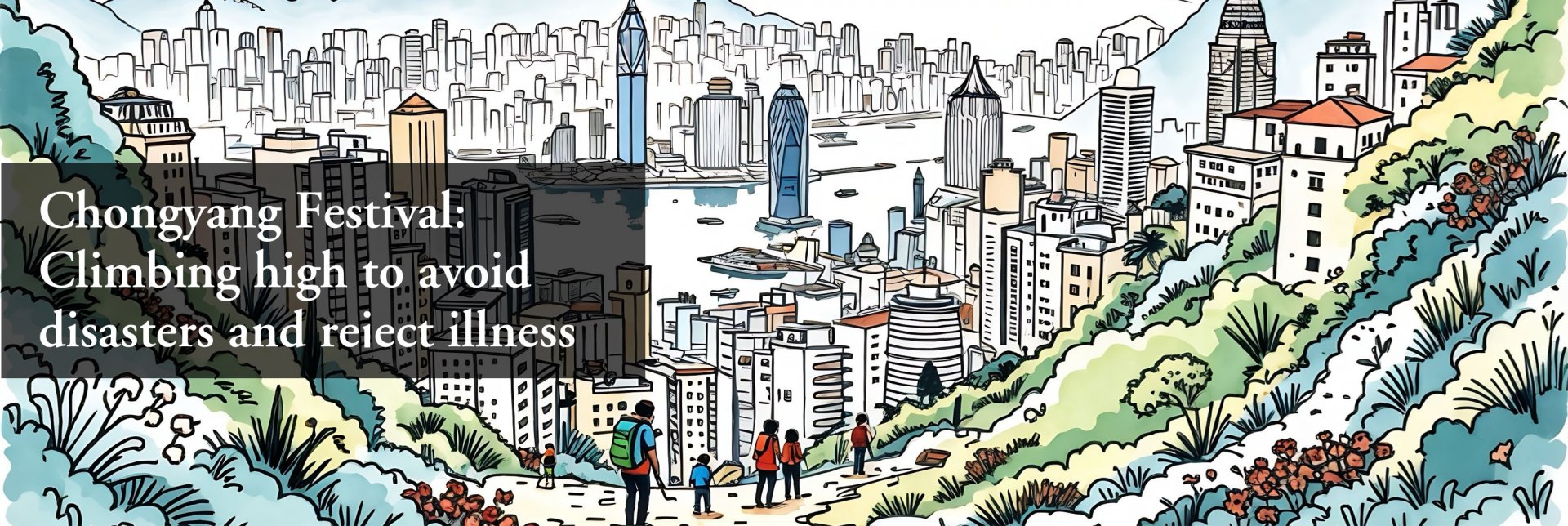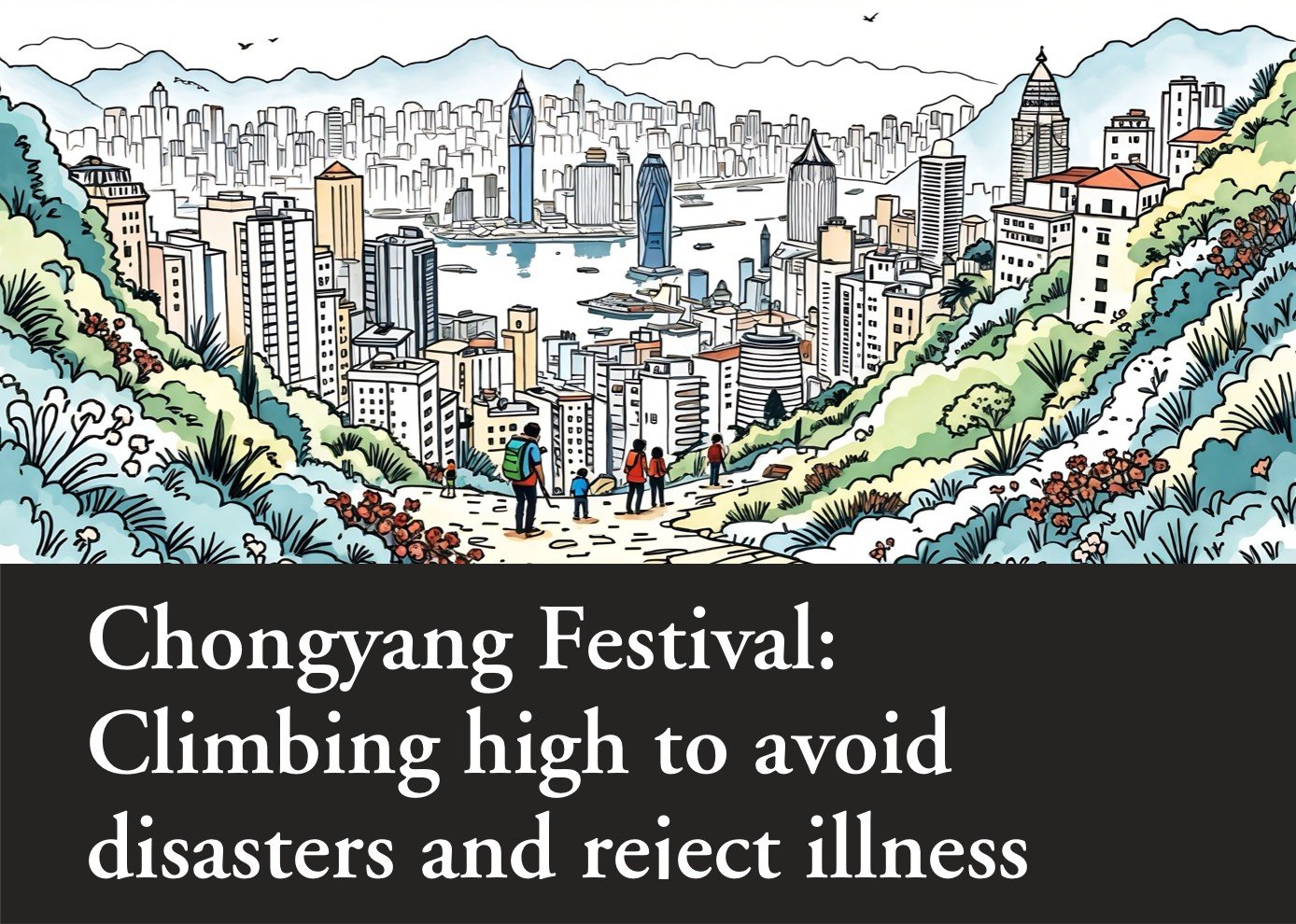Chongyang Festival:
Climbing high to avoid disasters and reject illness
I still remember the happy time with my family in Victoria Peak Garden (located near the summit of Victoria Peak) to enjoy the holiday of Chongyang Festival in every ninth day of the ninth lunar month, when I was a child. If the weather was clear, many citizens also liked to take their families to climb the peak and would see some of them flying kites at the summit. The summit become the popular place for people to celebrate the Chongyang Festival. This raises a question: why Chinese people climb the summit on the Chongyang Festival? Even today textbooks for primary and secondary schools state that the Chongyang Festival is related to a wise man named Huan Jing (桓景, ? - ?) who went up the mountain to avoid disaster. What is the content of this story?
First, let’s look at what’ s the origin of Chongyang Festival. Many scholars believe that the Chongyang Festival originated during the Warring States period (戰國時期, c. 475 - 221 BC) , as some of them reference the “Far Journey” (〈遠遊〉) in Chuci (《楚辭》), which mentions “集重陽入帝宮兮” (as the “重陽” in this verse is same with the “重陽” of Chongyang Festival [重陽節]) . The others believe this festival originated in the Eastern Han dynasty (東漢, 25 - 220)。 According to the extensive research by Yang Lin (楊琳), there is a record in The Monthly Decrees of Four Stratum (《四民月令》, which authored by Cui Shi [崔寔, ? - 170] ), which notes that the custom of picking chrysanthemum in double ninth day. That means Chongyang Festival had appeared by then. To the Jin dynasty (晉朝, 266 - 420; also divided in two times periods, Western Jin [西晉, 266 - 317] and Eastern Jin [東晉, 317 - 420]), many poems and writings mentioned the Chongyang Festival, showing that this festival had become widely celebrated by that time.
Why is the Chongyang Festival on the ninth day of the ninth month of the lunar calendar? In ancient Chinese divination culture, the number nine (九) is considered a “relative amount of Yang (陽數, means odd number)” as both the month and the day are associated with nine, representing the repeated “relative amount of Yang”, hence it is called Chongyang (重陽, or Double nine, as nine is the biggest odd number, so people use Yang[陽] to reference nine). According to the "Treatise on Calendars" (律曆志) in Book of Han (《漢書》) it is recorded that nine, seven, five, and three are the relative amount of Yang, and on the days with these number, the disasters occurred. Furthermore, according to the "Treatise of Food and Commodities" (食貨志) in Book of Han, Wang Mang (王莽, 45 BC - 23), who end the reign of Western Han dynasty (西汉, 202 BC - 8), faced consecutive years of disasters in the late of his reign, causing the people to suffer from poverty. Wang Mang then suggested to his ministers that the disasters from heaven were attributed to the yang nine, and that on the double ninth day, heaven brought calamities, causing the people to suffer.
As for why the Chongyang Festival is related to the story of Huan Jing ascending the mountain in ancient times. According to the “Treatise of Auspicious Signs” (符瑞志) of Book of Song (《宋書》), during the Eastern Jin Dynasty (東晉, 317 - 420) under Emperor Cheng of Jin (晉成帝 司馬衍 [Sima Yan], 321 – 342; 325 - 342 in-place), there was a person named Huan Jing (桓景). And combined with the story in Continuation of Mysteries Tales (《續齊諧記》) which describes Fei Changfang (費長房, ? - ?) suggested Huan Jing to ascend to avoid disasters, this story indicated that the disaster may occurred on the Chongyang Festival. To eliminate the disaster, the Chongyang Festival was established, and on that day, there is a custom of grazing livestock in the fields. Furthermore, in the poem Attend upon the Lord at Leyou Garden in Double Ninth day (《九日侍宴樂遊苑詩》) by Qiu Chi (丘遲, 464 - 508) from Liang of the Southern Dynasties (南朝梁, 520 - 557), it is said that ancient legends speak of a deity in the West who governs autumn. When the emperor travels in a chariot, a ritual to eliminate disasters and diseases is held, symbolizing the removal of misfortune. Therefore, on the double ninth day during the Eastern Han Dynasty, Huan Jing ascended the mountain with his family, and because the livestock were locked in the pen, they died in that day. To protect livestock, later generations began to graze them in the outskirts on the double ninth day to avoid disasters, leading to the belief that this day is one to avoid. At the same time, in some places in mainland China, there are folk customs during the Chongyang Festival involving throwing objects to ward off bad luck. For example, formerly in the Guangzhou area, children throw stones at each other on the ninth day of the ninth month to dispel misfortune. Thus, the folk custom of throwing away items on the double ninth day to seek to eliminate bad luck and avoid calamity has emerged, and Huan Jing and his family ascending the mountain on that day, known as "ascending high" (登高) is influenced by these folk customs.
Of course, people also fly kites during the Chongyang Festival. In today's Greater Bay Area (大灣區) cities, on the clear autumn day of the ninth day of the ninth month, people enjoy flying kites on the mountains. Additionally, in some regions of Fujian (福建), kites are flown both during the day and at night. In ancient times, kite flying was not just a recreational activity; it also held the meaning of warding off disasters and eliminating bad luck. According to the "Biography of Hou Jing" (侯景傳) in Book of the Southern Dynasties during the late years of Emperor Wu of Liang (梁武帝 蕭衍 [Xiao Yan], 464 – 549; 502 – 549 in-place), when the capital Jiankang (建康, today’s Nanjing [南京]) was besieged by the rebel Hou Jing (侯景, 502-552), a people who was stuck in Jiankang, made a crow-shaped kite out of paper and hid a letter of plea from the emperor inside it, then released the kite into the sky, hoping to deliver the message to the troops supporting Emperor Wu. The rebels, upon seeing the kite, were greatly frightened, believing it to be a form of witchcraft aimed at harming their soldiers. This shows that kite flying in ancient times was seen to eliminate disasters and transfer misfortune to others. In summary, the origin of the Chongyang Festival is related to the belief in avoiding calamities and disasters, both officially and among the people.
Why climb high? In folk customs, it was once popular to climb high and drink grain liquor, which was not necessarily an activity enjoyed only by common people, but more often held by the court and literati. In the quotation by Cui Shi in The Monthly Decrees of Four Stratum it mentions that "on the ninth day of the ninth month, people can pick chrysanthemums." (九月初九可採菊花) Scholars point out that this act of picking chrysanthemums is not done at home, but rather on the mountains, as the text refers to picking chrysanthemums as the act of climbing high. The ancients believed that going to the highest places in the mountains could bring blessings from the gods, and that one could find longevity herbs there, even achieving a status alongside the deities. Thus, climbing high necessitates going to the mountains, which is also why chrysanthemums are appreciated there. Ancient texts like The Monthly Decrees of Four Stratum have recorded that the ancients used chrysanthemums as offerings for deceased friends. In China, chrysanthemums are regarded alongside plum, bamboo, and orchid as the "Four Gentlemen of Flowers." (花中四君子) Today, in Xiaolan Town of Zhongshan City (中山市 小欖鎮) and in Taoist temples in Hong Kong, the Chrysanthemum Festival is celebrated in the ninth lunar month, featuring not only potted chrysanthemums but also chrysanthemum screens. During the Chongyang Festival, chrysanthemums that bloom in season are publicly displayed. In the Ming Dynasty (明朝, 1368-1644), during the Chongyang Festival, many people enjoyed gathering with friends to appreciate chrysanthemums on the mountains. Some families also liked to hold activities to admire chrysanthemums at home around the Double Ninth Festival, enjoying the flowers while singing poetry and playing chess. In Xiaolan Town, Zhongshan City, there are also delicious dishes like chrysanthemum snake soup (菊花燴蛇羹), chrysanthemum fried fish balls (菊花炸魚球), and chrysanthemum seafood (菊花海鮮).
We can see that today’s Hong Kong places greater importance on the Chongyang Festival. If the weather is clear, Victoria Peak Park remains a popular spot for many visitors to hike. Many citizens also like to pay respects to their ancestors at their graves or columbariums during the festival. Some people honor their ancestors with incense and candles, while others use chrysanthemums to show their filial piety. This can also be seen as a continuation of the noble tradition of honoring ancestors with chrysanthemums.
Reference:
Book
1. 劉琳:《重陽》(天津:天津人民出版社,2022)。
2. 舒龍:《歲歲重陽》(北京:海南出版社,1993)。
3. 香港婦聯[編]:《慶薈萃在中華 : 節日文化習俗選粹》(香港:香港婦聯,2015)。
All articles/videos are prohibited from reproducing without the permission of the copyright holder.




Welcome to leave a message:
Please Sign In/Sign Up as a member and leave a message